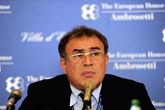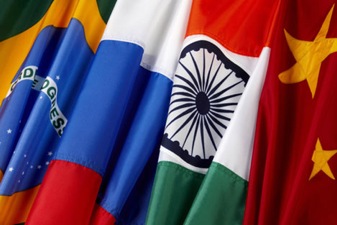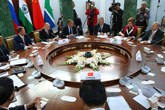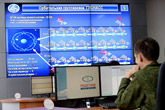BRICS prepares roadmap for investment cooperation
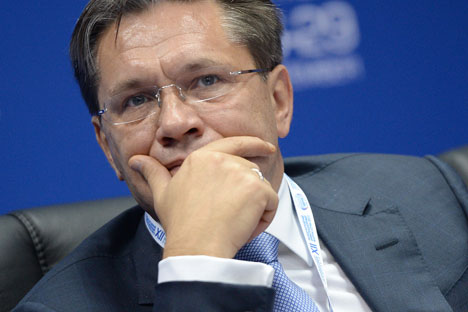
Alexei Likhachev: "The most promising areas of cooperation are energy, including atomic energy, the civil aircraft industry, the chemical industry, pharmaceuticals and information technology". Source: RIA Novosti / Ramil Sidtikov
With BRICS members increasing their political cooperation, it’s easy to forget that the grouping was initially formed for economic cooperation. In this interview with RIR, Alexei Likhachev, Russia’s deputy minister of economic development talks about the potential for BRICS to stimulate trade and reciprocal investment.
As of the end of 2013, did Russia’s trade volume with the BRICS countries increase?
According to preliminary data, trade volume remained at the previous year’s level. A small increase in trade with China and South Africa was offset by a slight decrease in trade with India and Brazil. The decrease in Russian export values occurred mainly due to a decline in market conditions for goods that Russia traditionally exports: hydrocarbon raw materials, metals and fertilizer. However, there were positive developments in a number of items that are of interest to us. Russian exports of machine technology products grew by a total of 5.8 percent, high-tech exports grew by 16.9 percent and exports of innovative products grew by 6.7 percent.
Imports into Russia continue to grow, including from the BRICS countries. We are not erecting barriers against introducing goods to our market. On the contrary, the barriers are shrinking because of Russia’s accession to the WTO.
What steps do the BRICS countries need to take in order to strengthen/renew trade growth?
Work needs to be done consistently with each partner country on increasing reciprocal trade—both bilateral and multilateral. This will be the main challenge of the upcoming BRICS summit and the meeting between the economics ministers.
For example, Russia and Brazil are concluding work on the Action Plan for Trade and Economic Cooperation between Brazil and Russia for 2014–2015, which was approved and signed during the summit and aims to raise bilateral trade to $10 billion, as our presidents decided.
We believe that adopting the BRICS Strategy for Economic Cooperation and the BRICS Roadmap for Investment Cooperation, which we are currently working on, will be an important step in this process.
What is the status of the preparation of the BRICS Strategy for Economic Cooperation?
As a result of the summit in Durban, we have worked on the plan for the strategy. This is a framework document that defines the priority areas of cooperation. The sections of the strategy are dedicated to trade and investments, manufacturing and the extractive industry, energy, transport and logistics, agriculture, innovations and technological exchange.
The work was conducted jointly with the Russian Foreign Trade Academy and academic experts, including from the BRICS countries. In the first place, we analyzed the national strategies and priorities of the partner countries. A “brainstorming session” that consisted of a series of seminars and conferences was organized with the UN Development Program and the Russian Foreign Trade Academy and brought together the diplomatic corps of the BRICS countries and representatives of the Russian private sector. The final conference was held at the Ministry [of Economic Development of the Russian Federation] on December 5, 2013, and included around 100 participants.
Now, the strategy plan is at the approval stage with the partners. Of course, we are trying to honour, as much as possible, all the partners’ substantive proposals and to complete the preparation of a final version of the document before the BRICS summit in order to present the strategy to our countries’ leaders.
We have also started preparing the BRICS Roadmap for Investment Cooperation, and along with the private sector we are preparing proposals from the Russian side. They are aimed at the interests of Russian companies. We are going to strengthen trade and investment cooperation, primarily in areas where we have definite competitive advantages. These are energy, metallurgy, agrarian production, transport and special machine building, and financial and banking activity. We think these sectors will become the “growth areas” that will enable the BRICS countries to strengthen their positions in the global economy and successfully withstand crisis situations.
After several years of growth in bilateral trade between India and Russia, why did it stop last year?
Unfortunately, in the 1990s, there was a collapse in our bilateral trade. Only in recent years has trade been growing consistently. Compared to the early 2000s, it has more than tripled. So talking about a halt to trade between Russia and India is not quite accurate.
Nevertheless, there is a task to increase trade volume to $20 billion in 2015, but right now this figure is $11 billion. Through what approaches do you intend to increase cooperation?
The most promising areas of cooperation are energy, including atomic energy, the civil aircraft industry, the chemical industry, pharmaceuticals and information technology. We hope to resolve the clear-cut problems that are linked to the construction in India, with our assistance, of new nuclear power plants; this will provide a substantial addition to bilateral trade. We have high hopes for the joint use of the GLONASS global navigation satellite system.
The possibilities for increasing our cooperation in a traditional sector such as metallurgy are far from exhausted.
Significant potential for increasing the volume of Russian-Indian economic cooperation lies in the realm of investment. It is obvious that the volume of reciprocal investments may be markedly increased and diversified in terms of industries.
In October 2013, the first meeting of the Russia-India working group on implementing priority projects of bilateral cooperation was held in Moscow. During this meeting concrete projects were approved, and an agreement on the development of a “roadmap” for their practical achievement was arrived at.
What are these projects?
Among the first projects chosen by this working group are the project to construct a butyl rubber factory in India with the participation of SIBUR, the Russian Helicopter project to organize a cooperative centre for building helicopters, the KAMAZ project on expanding truck production in India and the Tractor Factory project to put in place the collective manufacture of industrial tractors in India.
All rights reserved by Rossiyskaya Gazeta.
Subscribe
to our newsletter!
Get the week's best stories straight to your inbox
